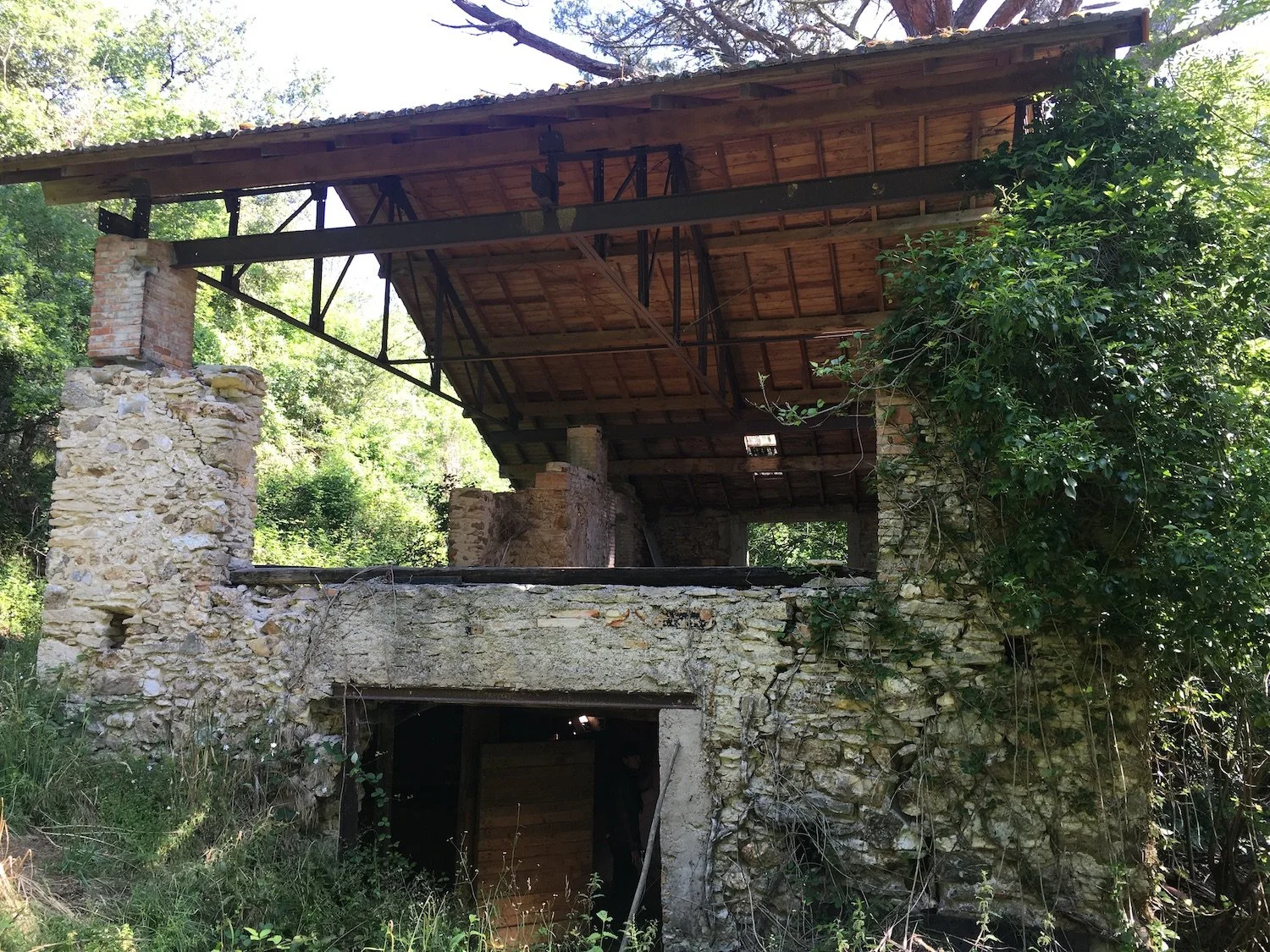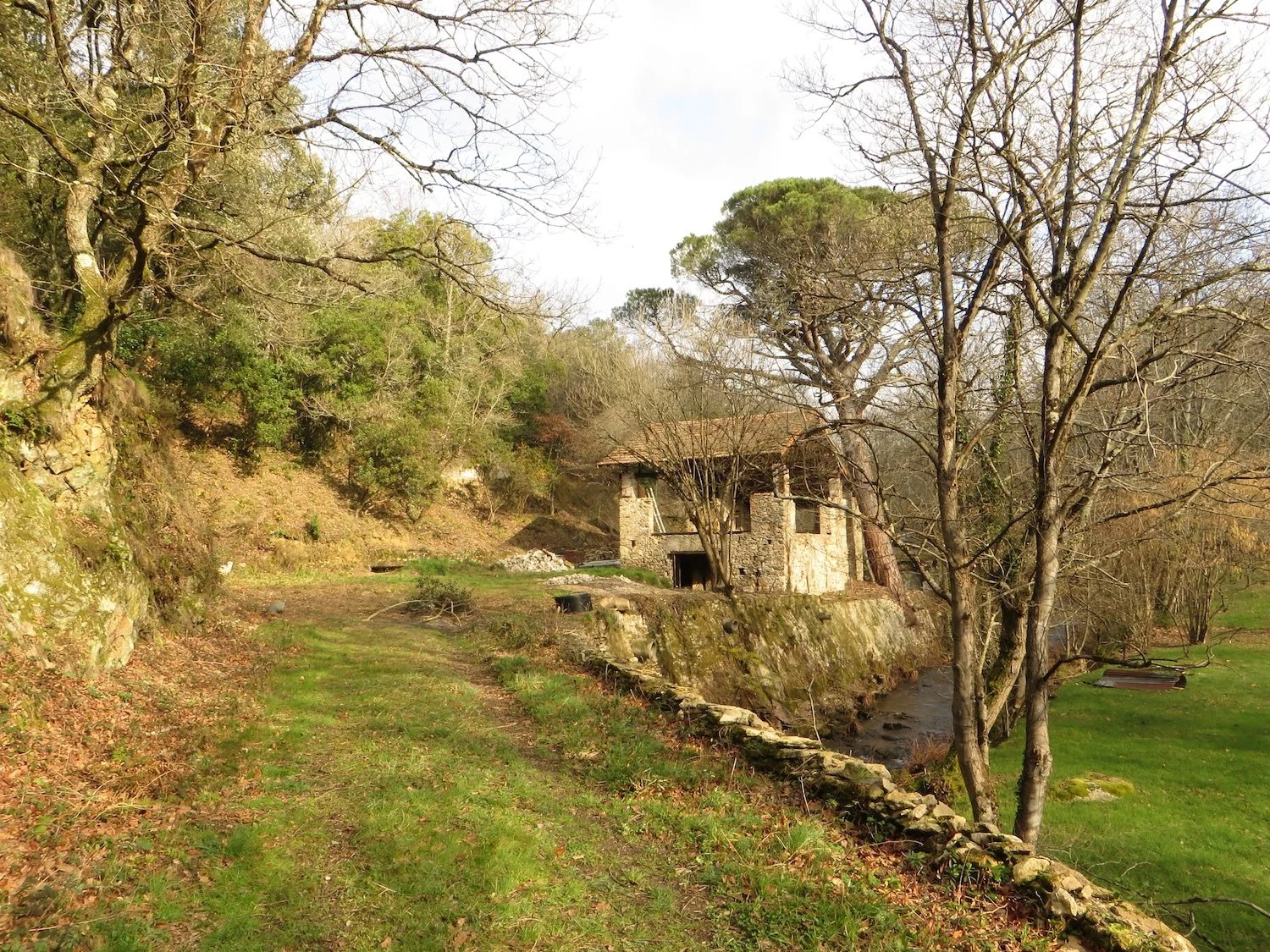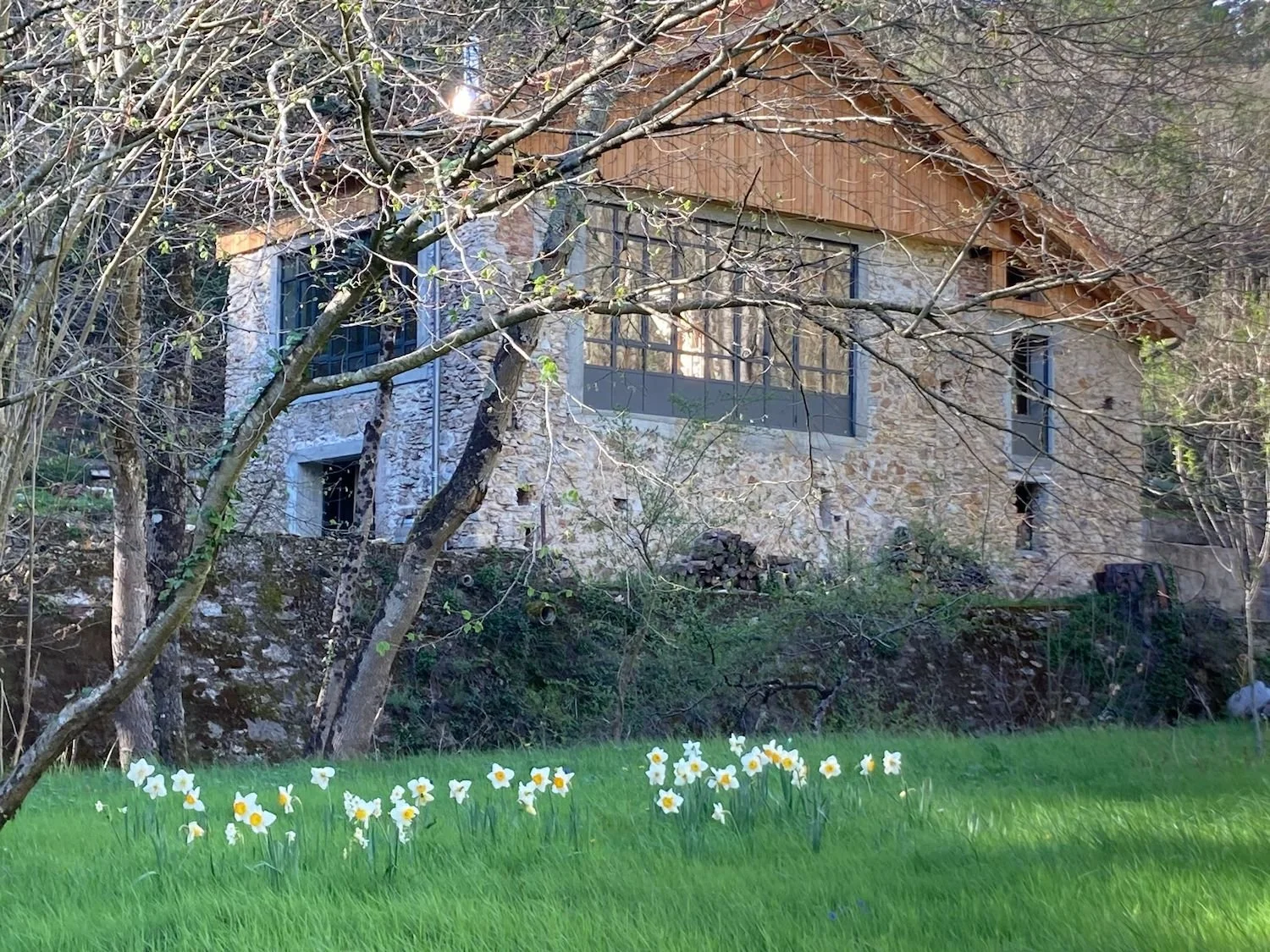FEBRUARY-MARCH 2024 - Part 5 - A Film and an Idea
Elliot, a teenage English boy, sits in the cabin of a broken-down, blue truck. Next to him is Clement, a French boy the same age who is inhaling deeply on a cigarette while recounting the story of the death of his mother. The words tumble out of Clement until he can find no more. He punches the steering wheel repeatedly and then grips it hard.
Elliot tentatively reaches out and touches his bloodied knuckles. For a moment Clement allows him.
In the confined intensity of the cabin the tension between them mounts until Clement shoves Elliot away and jumps out of the truck.
Later…
Elliot stands at the bottom of a long, rectangular crater lined in concrete and rock with a wild meadow underfoot. The sun overhead is bright. Elliot covers his eyes from the glare as he dodges sticks that Clement, stood high up on the side of the crater, is lobbing carelessly at him.
“It was a fish farm,” Elliot declaims. “There were thousands of fish, the water was boiling with them. It was disgusting. And then the dirty water drained out into the river over there. Wriggling over each other. No one can live like that!”
Eventually one of the sticks hits him on the head.
Two arrows protrude from bloody wounds in Elliot’s chest as he lies in the arms of Clement who holds him, heartbroken.
Moment’s later, Elliot comes to, lying on the grass with Clement standing over him, asking if he is alright.
-
Our neighbour, Dominique, stands beside me surrounded by the film crew watching this second scene through the monitor. We are shooting my first feature film, Departure. These scenes take place on the terrain of the Mécanique du Père, which Dominique owns.
Alex Lawther played Elliot and Phénix Brossard played Clement, with whom both Elliot and his mother, played by Juliet Stevenson, become infatuated. Most of the film was shot in and around Le Foulon, the fictional house that Elliot’s parents have sold and which he and his mother, Beatrice, are there to pack up.
It is a film about endings and beginnings. The shoot was scheduled over a month of autumn allowing my cinematographer and me to capture the changing colour of the forest and then condense it into the single week of the story itself. The screenplay, despite its dozens of rewrites over several years, maintained a sequence of scenes that shifted from morning to night, so as well as the autumnal month and the narrative week, there was also the sense of a single day passing. Because of the inevitable shuffling of scenes that takes place in the edit, that single-day structure gave way to the needs of the characters and their stories. Nonetheless, it remained an exploration of time and the way it thickens and folds.
A central event in the film was based on a holiday I had with my parents and my close friend, Tim, in a confined and stifling canal boat. The film explored elements of that holiday when I was fifteen and also my parent’s divorce two years later and then set the resulting story in a both real and allegorical landscape evocative of my nascent adolescence at the age of twelve. If the film has any flaws, (it has some flaws) they might in part be because of this compression of time, which rather than leading to a burning intensity, resulted in an occasionally miasmic vagueness.
Perhaps it is not a coincidence that the “inciting incident” central to the film – an ending and a beginning – occurred on a canal boat just twenty minutes south of Le Foulon on the Canal du Midi. Maybe landscapes carries memories as people do.
Certainly, new landscapes can stir old memories. Something in this valley stirred memories in me, and then provided the backdrop against which I translated those memories into a screenplay and then filmed it. The old, blue, broken-down truck, the collapsed interior of the ruin, the rectangular crater fringed with wild fig (actually, the remains of the ground floor of the old mill), all these took me to my adolescence and those bits of no-man’s land in the West Country where I would escape the house and forage for danger amidst the decay.
-
A year later, in 2015, Alex joined Filip, Nicholas and me in Cenne-Monestiés to watch a screening of the finished film. A projector was strapped to the ceiling of the old village cafe – also the location where we shot the fictional bar in the film. Benches were laid out and Alex and I clung anxiously to the banisters of the stairs at the back of the room.
A good number of the villagers came: the family who own the farm by the bend to Le Foulon with at least two of their dogs, the ex-mayor and the current mayor. Indeed, the mayor yet-to-be, José, who had painted the sets for the film. The mayor’s assistant, Mirette, was there of course because she had played the role of the notaire who managed the sale of Beatrice and her husband’s house. Small and attentive as a bird, Mirette had delivered the role with aplomb. The room was full. All went smoothly until a scene with Elliot alone in his bed in a moment of ecstatic revelation involving a carrot. The film froze on a close-up of his face, his eyes wide open as he gasps. The audience slipped outside to smoke while a second projector was found.
-
The next day, Filip and I walked up to the Mécanique to look around. I had had an idea. The owner before Dominique had built a wooden chalet up the slope above the rectangular crater. It was visible through a thicket of ash trees to the north of the main section of the forest.
It was the chalet and the forest that Dominique had fallen in love with. The overgrown, fragile ruin beneath the umbrella pine and the hollow remains of the old mill turned fish farm turned crater – only accessible to her down a steep, muddy path – fell more and more beyond her control.
What if Filip and I were to buy it, renovate the ruin and so have our own home, neighbours to Nicholas and David, and to Dominique too? Could we unclog the watercourse or béal that once lead water from the river upstream to turn the mill’s wheel? In so doing, could we fill the crater with water and create a natural pool or bassin?
We made an offer and Dominique accepted it. The purchase turned out to be rather complicated, partly because the deeds were not entirely in Dominique’s name and partly because the parcels of land we were buying lay in a non-constructable zone of special natural interest and were are also at risk of flood. Filip and I used this time to start clearing the land of old pipes and barrels, and of brambles and bindweed. As the scale of the task became evident we also started to wonder what on earth we were doing. We alternated our sleepless nights, taking it in turns to lose conviction that we would gain the necessary permissions to renovate the ruin. Fortunately, which ever one of us was less beset by such dread consoled and encouraged the other.
Meanwhile I got to know the mayor, Jean-Louis, who when not attending to the massive project of overseeing works to stabilise the long-neglected barrage wall would listen to me massage the ambition of our project into a shape that might finally be acceptable. Part lion, part poet, Jean-Louis is a retired doctor who grew up in the village and after a career practicing medicine between Carcassonne and Limoux had returned to Cenne- Monestiés and lived now in the house he was born in. Perched over a ravine that drops down to the river and the Chemin du Paradis below, his house is an expression of his relationship to the world. Too small for his towering presence, it is nonetheless vast in its library of books and memories. Several years later, while turning a blood sausage on the fire for our dinner, he remarked that he lives in two villages simultaneously: the village as it is now and the village as it was eighty years before. “It is full of ghosts,” he said.
We knew we would never be able to get the full planning permission or permis de construire necessary for the comprehensive renovation of a ruin such as ours. The three limitations on the land (non-constructible, Zone Nature 2000 and risque d’inondation) would cause the regional planning office responsible for this level of permission to block the project.
We were depending instead on the idea that the “ruin” which had its roof mostly intact and a considerable proportion of its walls still upright, could be considered a “building” that we were simply nudging into shape. If we were successful, we might be granted what is called a déclaration préalable – permission for modest renovations. Such permission is granted at the local mayor’s discretion.
On the afternoon after signing the purchase, I went to the mayor’s office with a Tupperware container of millionaire’s shortbread I had baked. I needed to confirm finally that Jean-Louis considered the project to be of a scale that fell into this latter remit. His remit. He may or may not give us permission but at least it would be decided by him. This was the summit of our hopes.
The lion paced his office, hesitated, shook his head and finally said we would need the full permis de construire.
I started crying. His second in command, Mirette, flew bird-like to the printer and inserted the official, letterheaded paper of the maire. Then she barred the door so that a heated Jean-Louis could not leave. Silence fell. Jean-Louis, satisfied that I knew how perilous the situation was, took a bite of millionaire’s shortbread.
Then he sat at his desk and started typing a letter, one key at a time. I didn’t move a muscle. Pausing between jabs at the keyboard he looked at me with resignation and regaled me with accounts of the threats he and I would receive from others denied similar permissions. I glanced at Mirette who gave me a shake of the head which means “bof” in French and something like “take no notice” in English. Jean-Louis scowled at us. “And if you are flooded,” he added between taps, “the mayor is not responsible.” A final, loud tap.
After an agonising ten minutes during which the computer would not connect to the printer, a hiatus which Jean-Louis took as a sign he should abandon the scheme, the letter finally slid out. Mirette rushed it to him with an un-capped pen. Raising his eyebrows critically at her, he lifted the letter off the desk and brushed away crumbs of shortbread from underneath.
The letter granted us permission to renovate the ruin into an industrial building in which we could do pottery, prepare films and store furniture such as beds, tables, chairs and wardrobes. “And we can put in a bathroom?” I asked quietly. “Of course!” he replied, waving away my question. “And a kitchen?” I pressed. “How will you eat otherwise!” he bellowed, delighted by the drama and infuriated by my incomprehension.
Before walking out of the room, he turned and covered his ears, then his eyes, then his mouth. Mirette smiled.
Once the blue truck had been removed and the bamboo thicket cleared, I considered what should be the first task. I decided it should be a potting shed made with oak from the forests of Ariège. What is more, I decided it should be made without nails or screw but rather with mortise and tenon joints and dowel rivets I would turn from off-cuts of the oak. Perhaps it was a statement of intent: that the thing should be the thing itself. Which is not a quote but a paraphrase of what I had understood to be the meaning of Robert M. Persig’s Zen and the Art of Motorcycle Maintenance, a book that I devoured in my teens. At last, I had something to build and through which I could test myself against his measure. And secondly, I was attracted to the aesthetic of the tools I would need to buy and the theatre of the actions I would undertake with their scent of chiselled oak and integrity. Needless to say, twelve long screws were called upon finally to reassure the structure and me.
The umbrella pine that leant so perilously over the ruin had to come down. Its falling branches had smashed the roof tiles, allowing in decades of rain to rot the beams and cause the floor inside to collapse. A local tree surgeon called Pierre brought the tree down. Branch by branch he severed and then sent flying along taut ropes the limbs of the tree. His wife and children watched from the meadow as he chain sawed through and then levered off the top third of the trunk slice by slide. Filip and I dashed about stacking the massive logs and collecting and burning the debris. On the last day and with the help of his father he hued out a triangular wedge or fromage near the base of the tree and then jumped back as the remaining seven meters of the massive trunk were pulled down by means ropes, pulleys and a tractor.
Nicholas, Filip and I counted the rings. It was over a hundred and seventy years old. Regardless of the impossibility of keeping the tree, I cling to Pierre’s diagnosis that it was already dying.
Eight years passed and the “ruin”, unfinished but finally closed to the elements, has become the “Atelier”. Concrete floors were installed as part of the initial works to stabilise the building by a rotund and very funny if chaotic builder called Anaïck. Adrien, a misfortune-prone metal-worker welded steel windows on site. The roof was re-constructed and then insulated with recycled champagne corks by Michel, an artist and inventor who lives in the village, with his son as assistant and me as his assistant’s assistant. For the rest, the works are done slowly by me except for during the holidays when Filip can leave the university where he teaches and join me.
It took us two summers to clad the open sides of the roof apexes in douglas fir felled in a good moon. The building is perched so precariously near the top of the retaining wall above the river that we were unable to use scaffolding. We straightened the long boards with a table saw and then, with harnesses and optimism, lined them up and fixed them into the void. I taught myself stone masonry with the help of a man in the village called Laurent who mixes his own lime renders with earth he collects from the Pyrenees. With the help of Youtube I have mostly wired the building although we were still dependent upon an extension cable run through the forest from Dominique’s chalet.
Meanwhile, we started to make a garden between the edge of the forest and the house, and on the lower part of the slope with its copse of ash trees below Dominique’s chalet. This rocky part of the garden lies beside the bassin with its waterfall that now spills from the end of the béal. From time to time with Dominique’s blessing we would nudge into her forest to raise the skirts of a tree or pull down the bindweed but otherwise we occupied ourselves with the building and the garden.
Until last summer when we were sitting with Dominique under the large spreading oak in front of the chalet. It was August 2023 and she told us she had decided to move and was going to sell the chalet and its two hectares of forest that border our slice of land.
-
It is a little over a month now since I boarded the train in a snow-covered Paris and came south to buy the forest with its boulder and wooden chalet. Technical rehearsals continue here in the Northeast of France. The blue-leafed branch is flown on and off the stage as required and I wake early most mornings to write.
-
Two years ago, I made David a book for his birthday: a compilation of photographs of the wildflowers around Le Foulon and the Atelier. As soon as I had finished it, the trees dotted along the valley floor and in the bordering forest seemed to cock an eyebrow and ask, “What about us?”
Now we own that forested slope to the west of Le Foulon and the Atelier, and I will seek to answer them. I will try to get to know each one and to understand how, together, our little forest lives and grows. And how Filip and I will grow alongside and within it.





